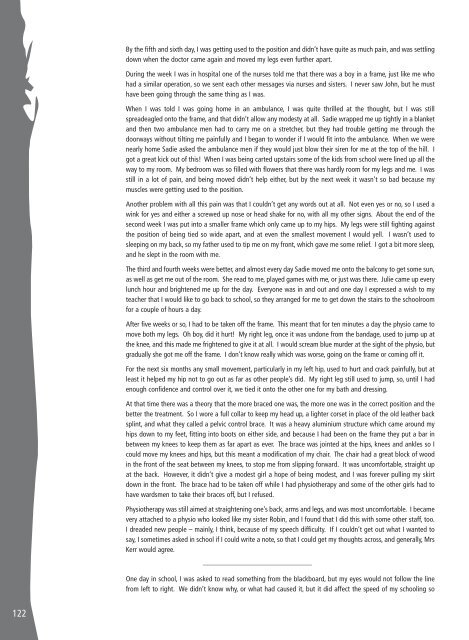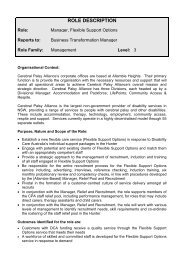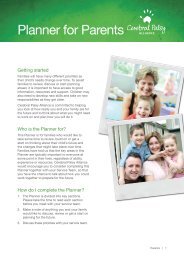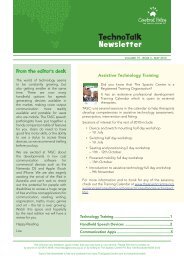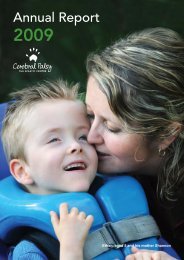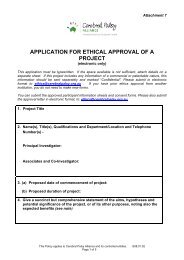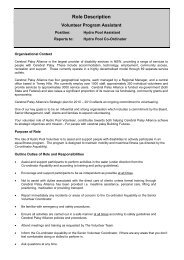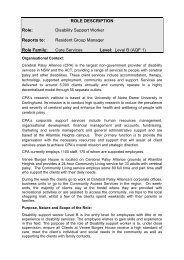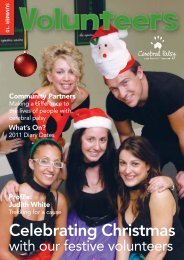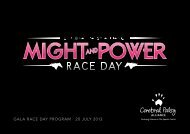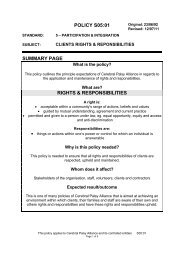'Nothing is impossible' - Part 2, chapter 4-8 - The Spastic Centre
'Nothing is impossible' - Part 2, chapter 4-8 - The Spastic Centre
'Nothing is impossible' - Part 2, chapter 4-8 - The Spastic Centre
Create successful ePaper yourself
Turn your PDF publications into a flip-book with our unique Google optimized e-Paper software.
By the fifth and sixth day, I was getting used to the position and didn’t have quite as much pain, and was settling<br />
down when the doctor came again and moved my legs even further apart.<br />
During the week I was in hospital one of the nurses told me that there was a boy in a frame, just like me who<br />
had a similar operation, so we sent each other messages via nurses and s<strong>is</strong>ters. I never saw John, but he must<br />
have been going through the same thing as I was.<br />
When I was told I was going home in an ambulance, I was quite thrilled at the thought, but I was still<br />
spreadeagled onto the frame, and that didn’t allow any modesty at all. Sadie wrapped me up tightly in a blanket<br />
and then two ambulance men had to carry me on a stretcher, but they had trouble getting me through the<br />
doorways without tilting me painfully and I began to wonder if I would fit into the ambulance. When we were<br />
nearly home Sadie asked the ambulance men if they would just blow their siren for me at the top of the hill. I<br />
got a great kick out of th<strong>is</strong>! When I was being carted upstairs some of the kids from school were lined up all the<br />
way to my room. My bedroom was so filled with flowers that there was hardly room for my legs and me. I was<br />
still in a lot of pain, and being moved didn’t help either, but by the next week it wasn’t so bad because my<br />
muscles were getting used to the position.<br />
Another problem with all th<strong>is</strong> pain was that I couldn’t get any words out at all. Not even yes or no, so I used a<br />
wink for yes and either a screwed up nose or head shake for no, with all my other signs. About the end of the<br />
second week I was put into a smaller frame which only came up to my hips. My legs were still fighting against<br />
the position of being tied so wide apart, and at even the smallest movement I would yell. I wasn’t used to<br />
sleeping on my back, so my father used to tip me on my front, which gave me some relief. I got a bit more sleep,<br />
and he slept in the room with me.<br />
<strong>The</strong> third and fourth weeks were better, and almost every day Sadie moved me onto the balcony to get some sun,<br />
as well as get me out of the room. She read to me, played games with me, or just was there. Julie came up every<br />
lunch hour and brightened me up for the day. Everyone was in and out and one day I expressed a w<strong>is</strong>h to my<br />
teacher that I would like to go back to school, so they arranged for me to get down the stairs to the schoolroom<br />
for a couple of hours a day.<br />
After five weeks or so, I had to be taken off the frame. Th<strong>is</strong> meant that for ten minutes a day the physio came to<br />
move both my legs. Oh boy, did it hurt! My right leg, once it was undone from the bandage, used to jump up at<br />
the knee, and th<strong>is</strong> made me frightened to give it at all. I would scream blue murder at the sight of the physio, but<br />
gradually she got me off the frame. I don’t know really which was worse, going on the frame or coming off it.<br />
For the next six months any small movement, particularly in my left hip, used to hurt and crack painfully, but at<br />
least it helped my hip not to go out as far as other people’s did. My right leg still used to jump, so, until I had<br />
enough confidence and control over it, we tied it onto the other one for my bath and dressing.<br />
At that time there was a theory that the more braced one was, the more one was in the correct position and the<br />
better the treatment. So I wore a full collar to keep my head up, a lighter corset in place of the old leather back<br />
splint, and what they called a pelvic control brace. It was a heavy aluminium structure which came around my<br />
hips down to my feet, fitting into boots on either side, and because I had been on the frame they put a bar in<br />
between my knees to keep them as far apart as ever. <strong>The</strong> brace was jointed at the hips, knees and ankles so I<br />
could move my knees and hips, but th<strong>is</strong> meant a modification of my chair. <strong>The</strong> chair had a great block of wood<br />
in the front of the seat between my knees, to stop me from slipping forward. It was uncomfortable, straight up<br />
at the back. However, it didn’t give a modest girl a hope of being modest, and I was forever pulling my skirt<br />
down in the front. <strong>The</strong> brace had to be taken off while I had physiotherapy and some of the other girls had to<br />
have wardsmen to take their braces off, but I refused.<br />
Physiotherapy was still aimed at straightening one’s back, arms and legs, and was most uncomfortable. I became<br />
very attached to a physio who looked like my s<strong>is</strong>ter Robin, and I found that I did th<strong>is</strong> with some other staff, too.<br />
I dreaded new people – mainly, I think, because of my speech difficulty. If I couldn’t get out what I wanted to<br />
say, I sometimes asked in school if I could write a note, so that I could get my thoughts across, and generally, Mrs<br />
Kerr would agree.<br />
______________________________<br />
One day in school, I was asked to read something from the blackboard, but my eyes would not follow the line<br />
from left to right. We didn’t know why, or what had caused it, but it did affect the speed of my schooling so<br />
122


